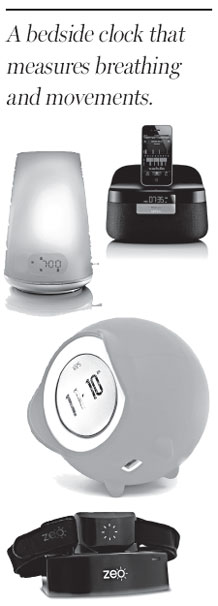New solutions for the sleep-starved
Updated: 2012-07-22 06:48
(The New York Times)
|
|||||||
Most of us need more than eight hours of sleep, but we tend to get six at best. Several technology companies have offered gadgets to address our collective fatigue.

One of the most straightforward is Clocky. Invented in 2005 by a Massachusetts Institute of Technology graduate student, Gauri Nanda, Clocky is an alarm clock on wheels. The $39 timepiece emits a cute bubbly animal sound, rolls off your night stand and trundles around your bedroom in the manner of a headless chicken. This behavior is adorable when you test the clock. First thing in the morning, it's not so endearing.
Tocky, Clocky's bubble-shape successor, has the same problem. It's better looking than Clocky, and it can play MP3s. But at $60, Tocky is more expensive than Clocky, and just as infuriating.
Like Clocky, the Philips Wake-Up Light ($70 to $160) tries to make morning inhospitable to sleep, though it takes a gentler approach. In addition to playing cheery bird sounds or broadcasting a favorite radio station (and, in some models, MP3s), the device gradually brightens in imitation of a sunrise.
I found that it worked quite well, waking to a room so bright I thought it was early afternoon.
|
Clockwise from top left: Philips's Wake-Up Light. Gear4's Renew SleepClock keeps tabs on repose by way of radio sensors. Tocky, a clock, rolls off the night stand. The Zeo Mobile Sleep Manager. |
At least one study has shown that prolonged use of light-therapy devices like the Wake-Up Light can help reduce the groggy feeling some people experience for a few hours after waking. I used the light for only about a week, so I didn't notice a significant change in my sleep patterns, but I did find that it made waking very pleasant.
The Zeo Mobile Sleep Manager, which sells for about $80 and works with Apple's iOS devices and Android phones, measures electrical activity in the brain by means of a headband to determine how you're sleeping. The Lark Silent Alarm Clock - $99, for iOS only - operates similarly, though with a wristband.
Then there's the Renew SleepClock, by Gear4, which sits at your bedside and measures your breathing and body movements through a pair of radio sensors. (It sells for $199 and works only with Apple devices.)
Sleep Cycle, a 99-cent iPhone app made by Maciek Drejak Labs, uses the phone's accelerometer to measure your mattress movements. The more restless you are, the less rest you are obviously getting.
The Zeo Mobile Sleep Manager is easy to use. And there's no need to be concerned about the very low-powered radio waves it emits, the manufacturer insists; it's entirely safe. But wearing a headband while you sleep is more than a tad goofy.
For that reason, I preferred the Lark's less obtrusive wristband technology. This product respects bedfellows not just by allowing the user to maintain sartorial dignity but also by signaling wake-up time with a silent buzzer in the wristband rather than a loud alarm.
The Lark, though, had its own troubles. Its battery needs a full charge to last through the night; if you forget to dock the device in the morning, it's useless.
The Renew SleepClock, by comparison, is a dream to use - just place it on your bedside table and plug it in. When you're ready to sleep, insert your device into the dock, and set the time.
Simplicity is also a selling point of the Sleep Cycle app - and at 99 cents, it's the best deal in dreamland.
But what do you get for all this sleep monitoring? Does analyzing your sleep actually help to improve it?
Maybe. While all the gadgets tried to wake me a few minutes before my scheduled alarm time, I still wanted to snooze. Besides, I don't need a graph to tell me how many hours I've slept, or the depth of my repose.
The hope, of course, is that I'll use the graphs to change my habits. With numeric proof that I'm cheating myself of sleep, maybe I'll drink less coffee and log off the computer earlier.
In other words, while these devices won't automatically improve sleep, they may be a handy aid in that effort.
Or, I could just turn out the lights and close my eyes - no tech required.
The New York Times
(China Daily 07/22/2012 page10)
